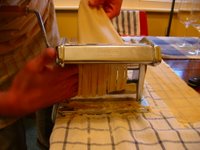
We are quite pleased with it so far: it is not the type of gadget that one is going to use everyday, but hopefully it won't be only gathering dust in the pantry.
Our first attempt at making pasta at home was successful. We thought about a sauce that would bring out the freshness of the pasta without overwhelming it, and came up with the idea of a porcini-based sauce using some milk. We made the sauce before tackling the pasta, just to get that out of the way.
Ingredients for the sauce:
- 40 g of dried porcini
- milk
- one small onion, finely chopped
- one garlic clove
- one bay leaf
- salt, pepper, nutmeg
Soak the mushrooms in a cup of boiling water for half an our. Heat some olive oil in a large saute pan. Press on the garlic clove with the side of a knife, and let it colour in the olive oil, along with the bay leaf. When the garlic is golden, add the onion. Let it fry gently without colouring. Squeeze as much water as possible from the soaked mushrooms, and coarsely chop them. Reserve the soaking liquid and strain it through a fine sieve. Add the mushrooms to the sautepan and let them fry for a few moments. Add the soaking liquid, let it get to the boiling point, reduce to low heat and slowly simmer until most of the liquid has evaporated. Season with salt, pepper, a bit of nutmeg. Add then about half a cup of milk, and reduce to a nice creamy sauce.
Ingredients for the fresh pasta:
-350 g of white bread machine flour
-2/3 eggs
We basically followed the instructions that came with the machine, but had to improvise a bit here and there. Various sources suggested different number of eggs for the same amount of flour. We decided to try to use as little egg as possible, and followed the instructions that came with the machine: 350g of flour and two (large) eggs. This was not enough, and a third egg was used. Below is a rough description of the whole process:
- Pile the flour on a working surface and make a well in the middle. Put the eggs (2 initially) inside this well, and with a fork start incorporating them into the flour, sort of like making cement. The eggs should bind all the flour; if not, add another one. Knead the flour by pushing it away from you, on top of the surface, with the back of your wrists. If necessary, add a few drops of warm water. The final consistency should be plasticine-like, without sticking to your fingers. Make a ball with the dough, put it in a bowl, cover with a damp tea towel, and let it rest for half an hour.
- Knead the dough a bit more, and cut it in 6 pieces. Cover the pieces of dough with a damp tea towel to avoid them drying up. Grab a bit of dough and pass it through the rolls, starting with the widest setting. Fold the sheet in two each time, and repeat 3-4 times. Gradually reduce the separation between the rolls, until you reach the thinnest setting. At this point, you should have a thin, long sheet that must dry for a bit before cutting. We hanged ours on a clothes drying rack:

- Before starting the cutting process, the dough must not be too wet. If it is, it will jam the machine. It should not be too dry either, as it will just crack when in contact with the blades. Cut each of the sheets of dough in half lengthwise, and pass each one through the cutter. Hang the fettucine again on the racks, as they should dry a bit more before cooking.

- Heat a large quantity of water in a big pot. Add salt. When it reaches the boiling point, add the fettucine. We did this in two batches. It takes literally a minute or two to cook the pasta, so be careful. Put the pasta directly in the sautepan containing the sauce, and add a bit of the cooking water to thin it. Fresh pasta seems to soak a lot of sauce, which on the one hand is good, but on the other can be a bit problematic, so the cooking water can be quite useful. Eat at once!


No comments:
Post a Comment